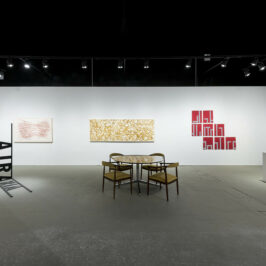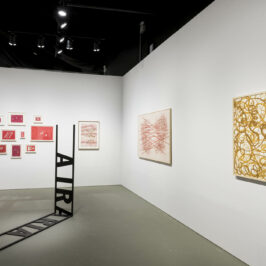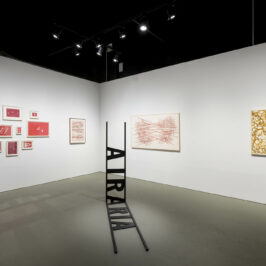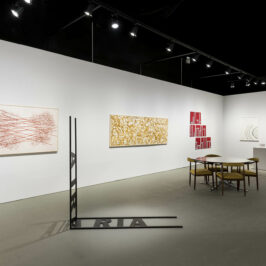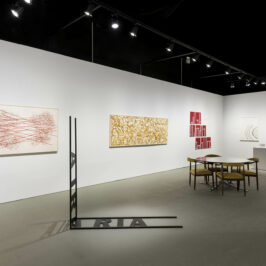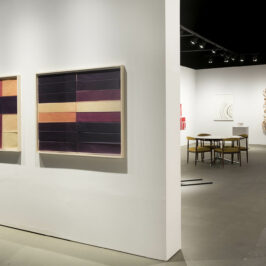arpa_ 2023
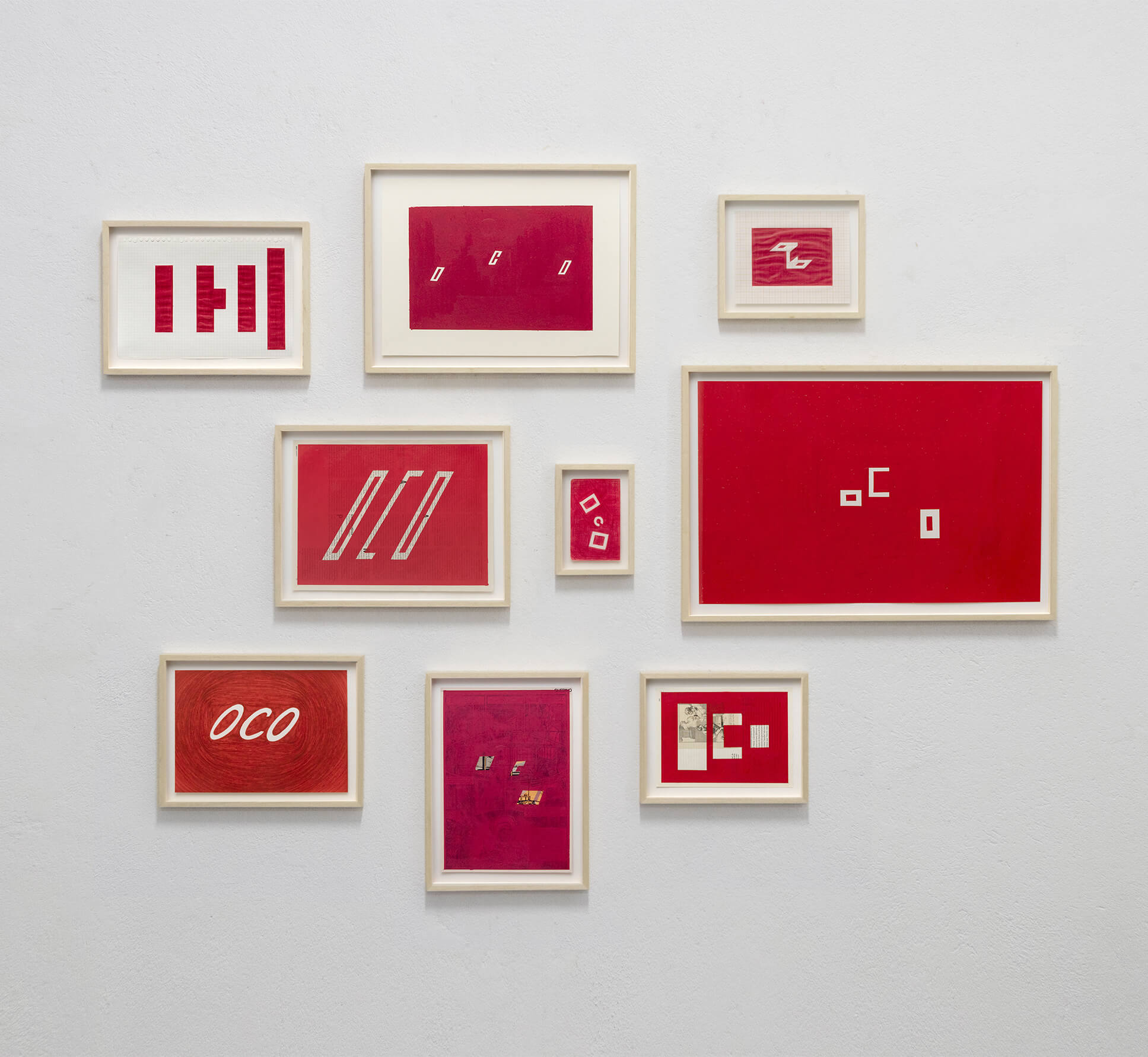
31 mai – 04 jun_ 2023
clique aqui e acesse o preview da feira ArPa 2023
Para a segunda edição da ArPa, a Galeria Raquel Arnaud apresenta Morfologia, projeto que destaca três artistas: Geórgia Kyriakakis, Carlos Nunes e Frida Baranek.
Morfologia – estudo da forma, da configuração, da aparência externa da matéria. Em linguística, morfologia é o estudo da constituição das palavras e dos processos pelos quais elas são construídas a partir de suas partes componentes. Os três artistas, cada qual à sua maneira, exploram a (des)configuração da forma, da palavra ou da matéria, propondo novas possibilidades e leituras. O projeto compreende obras em diversos suportes, incluindo duas esculturas.
Geórgia Kyriakakis mostra pela primeira vez uma obra da série “Senha”. O ponto de partida é uma palavra, escrita com fitas metálicas em vários pedaços de tecido. Essa palavra não se revela imediatamente, pois suas partes estão embaralhadas, desconfigurando, assim, a leitura e forçando o espectador a desvendar a “senha” para então ter acesso à palavra e, consequentemente, ao seu significado. Não existe uma única montagem. A ideia é que ela possa ser sempre trocada, inclusive durante os dias da feira.
Os palíndromos de Carlos Nunes aparecem em duas obras. Na escultura em ferro “A IRA RIA”, palíndromo criado pelo artista, fica clara a intenção de evidenciar a geometria da palavra. A obra em formato de “L” tem seu ponto de inflexão justamente no meio da frase, ou seja, se ela fosse dobrada ao meio encontraria uma sobreposição ou encaixe perfeito. O conjunto de desenhos “OCO” elabora de muitas formas a grafia dessa palavra, oca, curta, porém muito aguda ao sintetizar relações entre cheio e vazio, fundo e figura. Os desenhos são quase matrizes, negativos de si mesmos, já que as letras surgem do preenchimento do restante do espaço da folha
No vocabulário formal de Frida Baranek, são reconhecíveis as estruturas que remetem a redemoinhos, emaranhados, como na escultura “Uncertainty Relations XI”, em que as folhas de madeira, emboladas e aparentemente frágeis, no processo acumulatório criam volumes rígidos no encontro com o bronze. Essas articulações de materiais também se dão no papel. Na obra “The numbers tell the story”, fios de lã de bronze se misturam ao papel feito à mão, em um processo chamado colografia. O trabalho de Baranek pode assumir configurações diferentes, uma indeterminação morfológica que convida à participação.
Esse processo de configurar, desconfigurar, juntar, envolver, dobrar, estender, conectar, entrelaçar, misturar, montar, sobrepor, pendurar e dispor, seja no uso da palavra ou do material em si, une o trabalho desses três artistas e cria um universo único de possibilidades e transformações.
_________
For the second edition of ArPa, Galeria Raquel Arnaud presents Morphology, a project that highlights three artists: Geórgia Kyriakakis, Carlos Nunes, and Frida Baranek.
Morphology is the study of form and structure of something, and external appearance of matter. In linguistics, morphology is the study of the structure of words and the processes through which they are constructed from their component parts. The three artists, each in their own way, explore the (dis)organization of the form, of words or of matter, proposing new possibilities and interpretations. The project comprehends works in various media, including two sculptures.
Geórgia Kyriakakis shows an artwork from the series “Password” for the first time. The starting point is a word, written with metallic tapes in various pieces of fabric. This word does not reveal itself immediately, as its parts are shuffled, which disarrays its spelling and forces the spectator to unravel the “password” in order to access the word and, consequently, its meaning. There is not only one assembly. The idea is that it can always be changed, including during the days of the fair.
Carlos Nunes’s palindromes appear in two works. The iron sculpture “A IRA RIA” [lit. “the rage laughed”], a palindrome created by the artist, makes clear the intention of highlighting the geometric aspects of the word. The L-shaped piece has its point of inflection right in the middle of the sentence, that is, if it were folded in half, the two parts would match or overlap perfectly.The set of drawings “OCO” [“Hollow”] elaborates the many forms of the spelling of this word, which is hollow, short, and not with standing very sharp in expressing relations between “full” and “empty”, “background” and “figure”. The drawings are almost matrices, negatives of themselves, as the letters arise from filing in the rest of the space on the sheet.
In the formal vocabulary of Frida Baranek, it is possible to observe structures that invoke the idea of swirls, entanglements, like in the sculpture “Uncertainty Relations XI”, in which the apparently fragile veneer strips, entangled, create in this accumulative process rigid volumes as they mingle with bronze. These articulations of materials are also present on paper. In the work “The numbers tell the story”, strings of wool of bronze are mixed with handmade paper, in a process called collagraphy. Baranek’s work can assume different configurations, a morphological indetermination that invites participation.
This process of configurating, disarraying, joining, embracing, folding, extending, connecting, intertwining, mixing, building, layering, hanging and disposing, whether in the use of the word or the material, unites the works of these three artists and creates a unique universe of possibilities and transformations.


